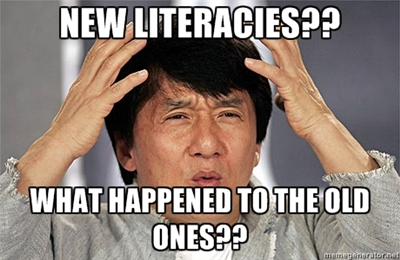Defining New Literacies and Why They Matter
New literacy is a concept that is a part of both my life as a teacher and as a mom. New literacies have been defined as “socially recognized ways of generating, communicating, and negotiating meaningful content through the medium of encoded texts within contexts of participation in Discourses” (Knobel & Lankshear, 2007, p. 24). This definition helps to show why we should be using a wide range of methods to communicate in both educational and family settings.
New Literacies Through a Teaching Lens
As a 4th-grade teacher, I can create more inclusive and engaging lessons and activities for my students by incorporating new literacies into our curriculum. I can tailor my instruction to the different learning styles and allow students to express themselves in a way that is meaningful to them using visual, audio, and digital media. Some examples from my classroom include using slide presentations and creating green screen projects where we share our persuasive writing. These uses increase student comprehension of the material and promote creativity and critical thinking skills.
New Literacies as a Parent
As a parent, I recognize the importance of teaching my children literacy skills from an early age. I try to expose them to a variety of communication methods, including digital and visual methods in addition to using traditional print-based literacy methods. This may look like reading e-books together, exploring educational apps, or creating and recording fun songs about what we are reading. My goal is to jumpstart their digital literacy skills and enable them to responsibly navigate the complexities of emerging technologies.
The Harm of "Old Literacies"
I also try to be aware of the limitations the traditional definitions of literacy have, especially in the world of education. Defining literacy only as proficiency in English ignores the different language and cultural backgrounds of students. This can potentially marginalize individuals who communicate through different languages or media types. Beecher (2023) points out that gives an example that upon analyzing a catalog promoting Mother’s Day, the mothers depicted were all young, White, well-dressed, and able-bodied. Students with mothers of different ages, races, classes, and abilities, would likely not feel as connected to or seen when viewing this catalog. Due to these systemic limitations, as both an educator and a parent, I am dedicated to promoting a more extensive understanding of literacy where multiple literacies are embraced and the value of diverse methods of communication are recognized in fostering equitable learning environments and preparing students for success in the future. I hope to teach my students and my children the skills and the confidence to get through and thrive in their education through this holistic approach to literacy.
Beecher, C. (2023, July). Chapter 1. What is literacy? Multiple perspectives on literacy. Methods of Teaching Early Literacy. https://iastate.pressbooks.pub/teachingearlyliteracy/chapter/what-is-literacy-multiple-perspectives-on-literacy/
PimaLib_JessicaP. (2017, August 14). Four things you should know about digital literacy [New literacies meme]. Pima County Public Library. https://www.library.pima.gov/blogs/post/four-things-you-should-know-about-digital-literacy/



Comments
Post a Comment